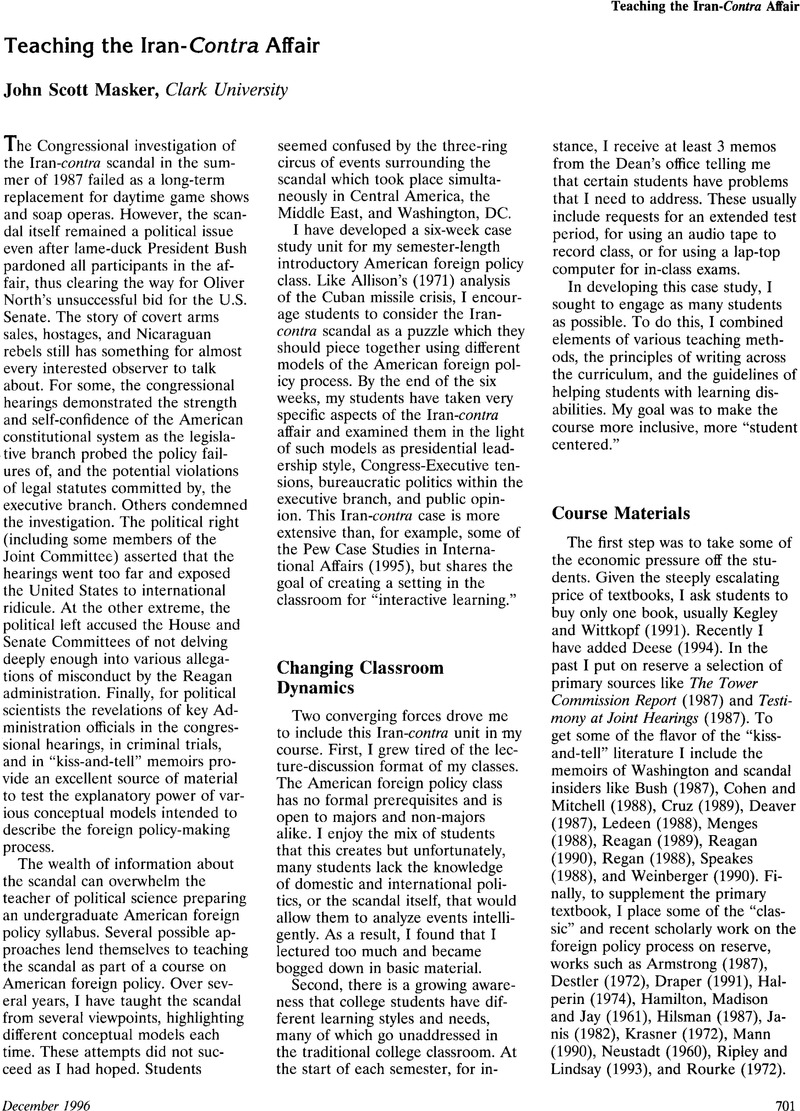No CrossRef data available.
Article contents
Teaching the Iran-Contra Affair
Published online by Cambridge University Press: 02 September 2013
Abstract
An abstract is not available for this content so a preview has been provided. As you have access to this content, a full PDF is available via the ‘Save PDF’ action button.

- Type
- News
- Information
- Copyright
- Copyright © The American Political Science Association 1996
References
Allison, Graham T.
1971. Essence of Decision: Explaining the Cuban Missile Crisis, Boston: Little, Brown.Google Scholar
Armstrong, Scott. 1987. The Chronology: The Documented Day-by-Day Account of the Secret Military Assistance to Iran and the Contras. New York: Warner Books.Google Scholar
Deaver, Michael K., with Herskowitz, Mickey. 1987. Behind the Scenes. New York: Morrow.Google Scholar
Deese, David A.
1994. The New Politics of American Foreign Policy. New York: St. Martin's Press.Google Scholar
Destler, I. M.
1972. Presidents, Bureaucrats, and Foreign Policy: The Politics of Organizational Reform. Princeton, NJ: Princeton University Press.Google Scholar
Draper, Theodore. 1991. A Very Thin Line: The Iran-Contra Affairs. New York: Hill and Wang.Google Scholar
Fassler Walvoord, Barbara E.
1986. Helping Students Write Well: A Guide for Teachers in All Disciplines. New York: Modern Language Association.Google Scholar
Halperin, Morton H. with Clapp, Priscilla and Kanter, Arnold. 1974. Bureaucratic Politics and Foreign Policy. Washington, DC: Brookings Institution.Google Scholar
Hamilton, Alexander, Madison, James and Jay, John. 1961. The Federalist Papers. New York: New American Library.CrossRefGoogle Scholar
Hilsman, Roger. 1987. The Politics of Policy Making in Defense and Foreign Affairs: Conceptual Models and Bureaucratic Politics. Englewood Cliffs, NJ: Prentice-Hall.Google Scholar
Janis, Irving L.
1982. Groupthink: Psychological Studies of Policy Decisions and Fias-coes. Boston: Houghton Mifflin.Google Scholar
Kegley, Charles W. Jr., and Wittkopf, Eugene R.
1991. American Foreign Policy: Pattern and Process. New York: St. Martin's.Google Scholar
Krasner, Stephen D.
1972. “Are Bureaucracies Important? (or Allison Wonderland).” Foreign Policy
7.Google Scholar
Mann, Thomas E.
1990. A Question of Balance: The President, the Congress, and Foreign Policy. Washington, DC: Brookings Institution.Google Scholar
Menges, Constantine C.
1988. Inside the National Security Council. New York: Simon and Schuster.Google Scholar
Neustadt, Richard. 1960. Presidential Power: The Politics of Leadership. New York: John Wiley and Sons.Google Scholar
Nordlinger, Eric A.
1981. On the Autonomy of the Democratic State. Cambridge, MA: Harvard University Press.Google Scholar
Pew Case Study Center. 1995. Pew Case Studies in International Affairs, 1995 Case Catalog. Washington, DC: Institute of the Study of Diplomacy, Walsh School of Foreign Service, Georgetown University.Google Scholar
Poindexter, John. 1987. Testimony at Joint Hearings before the House Select Committee to Investigate Covert Arms Transactions with Iran and the Senate Select Committee on Secret Military Assistance to Iran and the Nicaraguan Opposition, 1987. 100–8, pp. 343–44.Google Scholar
Ripley, Randall B. and Lindsay, James M., eds. 1993. Congress Resurgent: Foreign and Defense Policy on Capitol Hill. Ann Arbor: University of Michigan Press.CrossRefGoogle Scholar
Rourke, Francis E.
1972. Bureaucracy and Foreign Policy. Baltimore, MD: The Johns Hopkins University Press.Google Scholar
Testimony at Joint Hearings before the House Select Committee to Investigate Covert Arms Transactions with Iran and the Senate Select Committee on Secret Military Assistance to Iran and the Nicaraguan Opposition, 1987.Google Scholar
Tower, John, Muskie, Edmund and Scowcroft, Brent. 1987. The Tower Commission Report. New York: Times Books.Google Scholar


